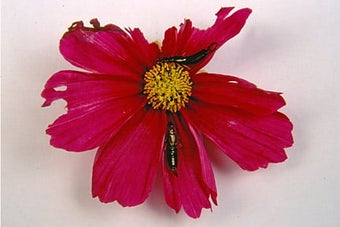
Quick facts
Common name - Clematis slime flux
Scientific name - Various species of bacteria
Plants affected - Clematis
Main symptoms - Wilting, accompanied by a foul-smelling, slimy ooze
Caused by - Bacteria
Timing - Most common in spring
What is clematis slime flux?
Clematis slime flux is a bacterial problem that can affect most clematis species. Damaged areas of stem are colonised by bacteria, leading to wilting, dieback and the appearance of a foul-smelling exudate from the stem. The disease can be fatal, but plants can sometimes be saved by the pruning out of affected parts.
Slime flux symptoms can also develop on the stems of a wide range of other trees and shrubs.
Symptoms
You may see the following symptoms on affected clematis:
- Yellowing and wilting of the foliage, particularly in spring and early summer. The symptoms may be confined to individual branches, but most of the plant can wilt if main stems are affected
- Occasionally, a plant will fail to leaf out at all in spring
- A thick, frothy or slimy ooze, often foul-smelling, is produced from the stem below the point where the foliage is wilting. This exudate may be white, pink, yellow or orange in colour and often runs down the stem from the point of production
- Stems may die above the point of infection
Control
Non-chemical control
- It can be difficult to prevent the stem damage that leads to the development of clematis slime flux. However, protecting plants from strong winds and frosts, and taking care when digging and working around them, may help
- It is sometimes possible to save an affected clematis by pruning out the stem below the point of slime production. With any luck, the plant will then re-shoot
- If a plant dies from slime flux it should be safe to remove it and replant with another clematis. In addition to removing the plant (with its root system) it would also be prudent to replace some of the soil in which it was growing with fresh topsoil
- No control measures are recommended in the case of slime fluxing and wetwood on trees. Here the production of is regarded as being similar to the operation of a safety valve, enabling the release of gasses produced by the bacteria. Affected trees may be otherwise healthy for many years, but in any case it is not possible to prevent any branch dieback that may result
Chemical control
There are no chemicals available for the treatment of slime flux.
Biology
Clematis: clematis slime flux develops when a damaged part of the stem becomes colonised by bacteria that normally reside harmlessly in the soil or on the stem surface. Any factor that injures the stem can lead to the problem developing, for example;
- Frost damage
- Feeding damage from invertebrates such as slugs and snails
- Any type of mechanical damage (including strong winds twisting the stems)
- Even natural growth cracks
- Infection may also sometimes occur through the root system
The bacteria penetrate deep into the stem tissues, and when the sugary rises in spring this is fermented by the bacteria to produce the foul-smelling slime. Gasses are also produced which force the slime out under pressure and may result in further stem splitting. A range of bacterial species, as well as other organisms such as yeasts and fungi, are often found within the slime, all taking advantage of the sugars within the sap.
Other trees and shrubs: slime flux and a similar phenomenon called bacterial wetwood are also found quite frequently on the stems of a wide range of trees and shrubs. The biology is similar to that of clematis slime flux, although it is thought that in trees the bacteria most usually colonise the plant through the roots. Weeping and fluxing from patches on the trunk is often the only symptom, but branch dieback may occur.






